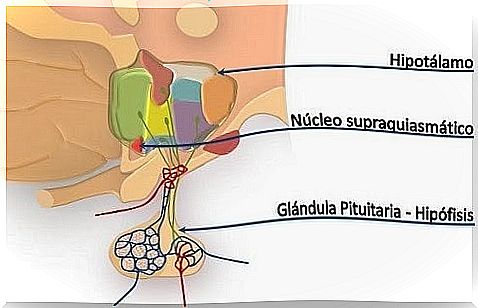Suprachiasmatic Nucleus: Our Sleep-wake Circadian Center

The suprachiasmatic nucleus is located in the anterior region of the hypothalamus and contains approximately 20,000 neurons. Its function is as fascinating as it is decisive: it works as our internal clock regulating the sleep and wake cycles.
Thus, thanks to the stimuli it receives through our retina, it allows us to be more or less active depending on the time of day in which we are.
We humans, like animals, are sensitive to changes taking place around us. The Earth and its rotation set the patterns of light and temperature that condition our level of activation. All this facilitates our adaptation. Therefore, our metabolism is, in a way, closely linked (although sometimes it may not seem like it) to nature.
These circadian rhythms, in turn, are surrounded by the most interesting areas of our brain. In this way, regions such as the suprachiasmatic nucleus are transformed into regulatory “centers” capable of orchestrating precise neuronal and hormonal events to control aspects such as rest, energy, body temperature and hunger.
Let’s see more data below.

Suprachiasmatic nucleus: location and functions
In reality, we do not have a single suprachiasmatic nucleus. We have two, and both are located in each cerebral hemisphere and very close to the hypothalamus. Thus, they integrate just above the optic chiasm with one purpose: to receive the signals captured by the retina to regulate, in this way, a large number of biological processes.
Studies like the one published in Frontiers in Neuroscience by Dr. Joseph L. Bendot do not hesitate to call the suprachiasmatic nucleus the brain clock. Furthermore, it is known that this brain structure favors processes as relevant as memory and learning.
Therefore, having adequate and restorative sleep remains essential for our brain and for each of its processes.
Thus, any function of the circadian system is related to illnesses ranging from sleep disorders to memory loss (especially severe in elderly people).
How does the suprachiasmatic nucleus work?
The functioning of the suprachiasmatic nucleus is complex. The biochemical processes that take place in it are very precise and, at the same time, complicated. However, we can understand its development more simply if we divide it into stages:
- This area receives information about ambient light through our retina;
- The retina not only has photoreceptors with which to distinguish shapes and colors; it also has ganglion cells, rich in a type of pigment called melanopsin;
- This pigment and its cells carry information directly to the suprachiasmatic nucleus. Later, after analyzing the information received, it will send signals to the superior cervical ganglion for the pineal gland to secrete or inhibit the production of melatonin.
- If it is at night and there is no sunlight stimulation, melatonin secretion will increase to reduce the level of activation and promote sleep.

The suprachiasmatic nucleus is the master of the rest of our “internal clocks”
Scientists have been discovering more data about this structure for a few decades now thanks to the Drosophila fly . As we well know, this insect and its study are providing us with valuable information about fundamental principles of biology and genetics.
We now know that the suprachiasmatic nucleus helps us maintain circadian rhythms by coordinating the synchronization of many other internal “circadian clocks”. Because beyond what it may seem, both our body and brain have hundreds of mechanisms that regulate a multitude of processes and behaviors.
The processes that it would help to regulate would be the following:
- The feeling of hunger;
- Digestive processes;
- Favors hibernation in animals;
- Regulates our body temperature;
- It also regulates the production of hormones, such as growth hormones, for example;
- It helps the brain and our body to carry out maintenance and restoration tasks. All this during the REM phase.

Alterations of the suprachiasmatic nucleus
The functioning of the suprachiasmatic nucleus can be altered by many factors. Many of them derive from our lifestyle habits:
- Spend a lot of time in front of electronic devices at night, such as a cell phone or computer, for example;
- Not following a fixed routine in our schedules;
- Jetlag (decompensation caused by the change of time zone);
- Living in cities with a high degree of pollution.
Furthermore, the suprachiasmatic nucleus has a direct relationship with the pituitary and with the production of melatonin. As we can intuit, it is common that, as we get older, the levels of this hormone decrease. All of this causes sleep disorders, tiredness, memory loss, exhaustion, discouragement, etc.
Furthermore, neurodegenerative diseases such as Alzheimer’s have also been found to cause a progressive loss of the neurons that make up the suprachiasmatic nucleus.
Therefore, it is ideal that we try (as far as possible) to take care of our routines. It would be ideal if we started to follow a schedule that does not have too many variations, especially regulating the light exposure of electronic devices.








